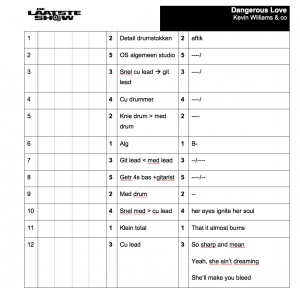Paperless TV Production
I still remember the first day of my career vividly, back in 1999. I just left RITCS, the art school in Belgium where I studied to become a TV director. My first job was directing a daily talk show: De Laatste Show. Actually, it was the first daily talk show ever, to be made in Belgium. The show ended with a musical performance. So I was exhilarated and as always well-prepared. I printed a “decoupage”, as we call it, with the lyrics, bars, camera shots etc..
This is what it looked like, it’s in Dutch, but you get the idea.
I made a copy for every cameraman, assistants, light engineer… About 5 pages for about 10 persons, so 50 pages in total. Then, the showrunner entered the studio with the script of the show. A fat bundle of 30 pages, which he copied about 20 times for everybody. So about 600 pages in total. In the meantime, the PA created a rundown that fitted on 1-2 pages, based on this script, so the whole technical crew knows what’s about to happen. It took her about an hour to create this rundown. This rundown was again copied about 20 times. So 40 pages in total.
We rehearsed every song 2 or 3 times, writing all corrections on these sheets. And because it was live music a lot of changes were made. With creative artists, it never goes as planned! So some more printing of the updated decoupage was necessary. And we started writing our cues on the script, camera shots, last words all over again… And after rehearsals, a lot of things changed again, and the showrunner ended up printing parts of the show all over again. And we started copying our cues again… you get it!
Sometimes a guest was delayed and we needed to change everything last minute, that was crazy. More printing! And errors because of miscommunications and outdated paper documents.
In sum, our daily talk show involved printing about 700 to 800 pages per day. Poor trees! Poor us! Because the moment we got these printed papers, we already knew they were outdated. When the showrunner handed out the script, he started with the remark that: “The clip about the singing crocodiles has been rejected by the host, so please cross it out.“
Imagine how we would have benefitted from a paperless approach, with a realtime document, shared by all and updated with every change.
In the past years, I tried many times to work via a pdf-editor on my tablet. Technically, that is paperless. But it just didn’t work the way I wanted to. I couldn’t edit swiftly, I couldn’t insert extra content in a quick and easy manner. Working with a laptop I also found quite hard in most studio control rooms. When I flipped it open, I was always covering the intercom. These control rooms are not (yet) made to work paperless.
Our show was not unique in its dependency on paper documents. Checkout this ‘behind the scenes’ from Saturday Night Live. Now, imagine how much they could benefit of a paperless workflow.
With TinkerList, the company I founded, we try to improve the making of television shows, by having one online integrated TV show scripting and rundown, that allows for real time editing and collaboration. For the design of our software, we talked to many directors, PAs, vision mixers, audio mixers, floor managers… to create an application for their specific needs.
And I must admit, it was not easy! We started creating a collaborative script where all producers can type together like in a Google Document. Then we made different views, that function like filters to show only what you need: a cameraman wants to see the script as a rundown, the director the cameras next to the script, the autocue operator what he needs to prompt…
Everyday, we work hard still, to achieve this paperless approach. We are optimizing view per view, still having long conversations with TV making experts, creating a lot of mockups and testing them. We have been continuously improving our software, for 4 years now.
We think we have become successful in going paperless! TinkerList is now used by talk shows, quiz shows, panel shows, events… in Belgium, the Netherlands, Germany, UK, Slovakia and Turkey. Our innovation trajectory is still ongoing, in close collaboration with our customers. We still learn about how television is made in different places, with every new customer.
Do you have tips for going paperless in television making, drop me a comment below!
